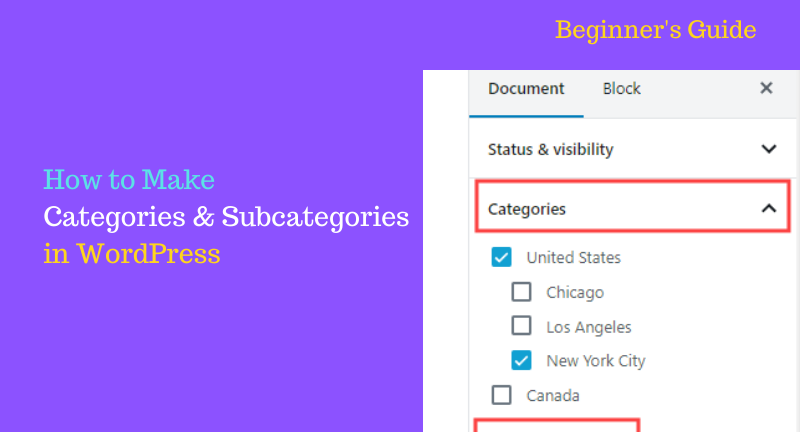
A reader recently asked us how to make categories and subcategories in WordPress. Well, here’s the workaround for how you can easily make categories and subcategories (child categories) in WordPress.
WordPress allows you to organize your content into categories and tags. You can also make subcategories for even more structure.
It’s critical to use categories and subcategories effectively so that your readers can locate the material they’re looking for. Solid content categorization can also help your website’s SEO performance.
This tutorial will walk you through the process of making categories and subcategories in WordPress.
Well, before heading towards making categories and subcategories in WordPress, you need to understand parent and child categories in WordPress. So, let’s see what is it and why it’s important though?
Table of Contents
Categories are a very useful tool. They’re more than just a means to organize your stuff. They also assist you in developing a relevant and semantic site structure. This is excellent for WordPress SEO.
You’re might be seriously wondering why and when someone would have to employ child categories (subcategories) on their WordPress.
Assume you’re starting a travel blog for various places throughout the world. You may like users to be able to search for articles by nation as well as city.
You might, for example, write an essay about the top watersports in the United States. This would make logical sense to categorize the post under ‘United States.’
However, you may also have posts about the best places to dine in New York City, Los Angeles, Chicago, and other cities.
You can utilize child or subcategories here as well. The parent category can be ‘United States,’ and the child categories can be cities.
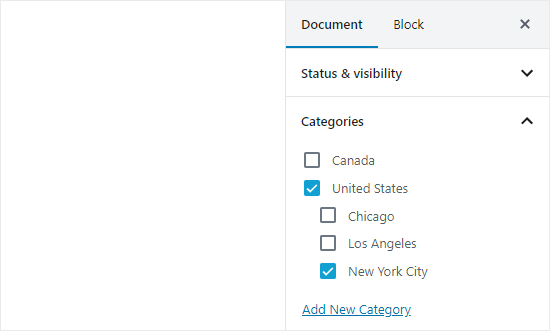
A post posted in a child category does not have to be filed in the parent category as well. In our case, we might have left ‘United States‘ unchecked and just categorized the post as ‘New York City.’
If you submit a post to the child category but not really the parent category, it will only display on the archive pages of the child category. This is very useful for avoiding duplicate content.
Having stated that, let’s look at how to make categories and subcategories in WordPress easily.
During the time of writing a post in WordPress, you can easily make a category. To do so, go to the document panel on your right, and click on the Categories tab.
Now, simply click on the ‘Add New Category‘ link to make your new category as you want.

Once you click on the link, two boxes will appear in front of you. You can add your category there. But, if you wish to make a regular category, there’ll be nothing to select from the Parent Category dropdown.
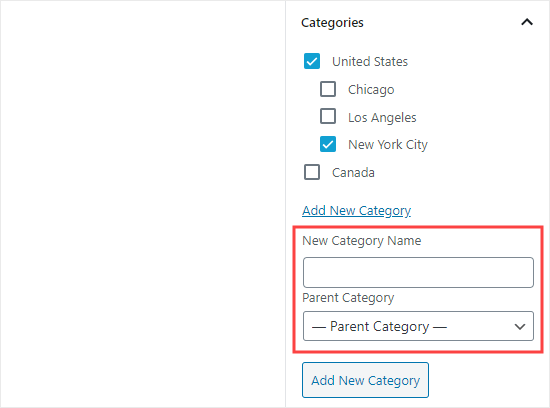
When you’ll be done typing your new category name, click on the ‘Add New Category‘ button. The category box for your current post will thereafter be checked automatically. If you prefer, you may uncheck it.

Creating a new category without any editing of your post is also possible.
Well, go to Posts > Categories to add your new category. The wise decision will be- creating all categories before adding content to them.
You can also edit the slug (URL) for your categories using this method. However, you’ll be able to delete/rename the categories as you want. Plus, you can even put a description here.
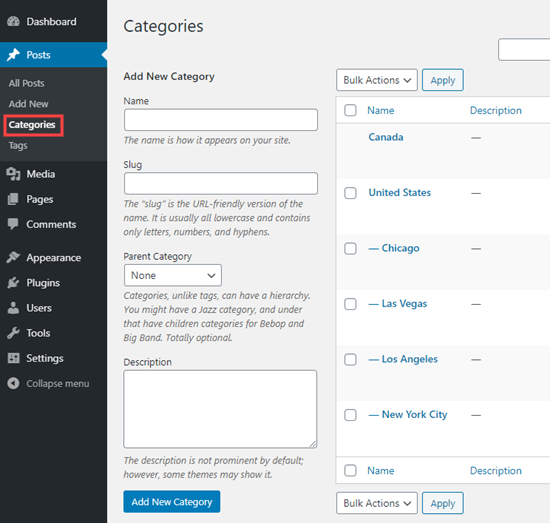
The way you applied above to make a category in WordPress, is the same way you can apply and make a subcategory in WordPress.
Open up the Categories tab whenever you edit a post. Then type the name which you’ll have for your child category. Now, click on the dropdown and select the Parent Category that you want to use.
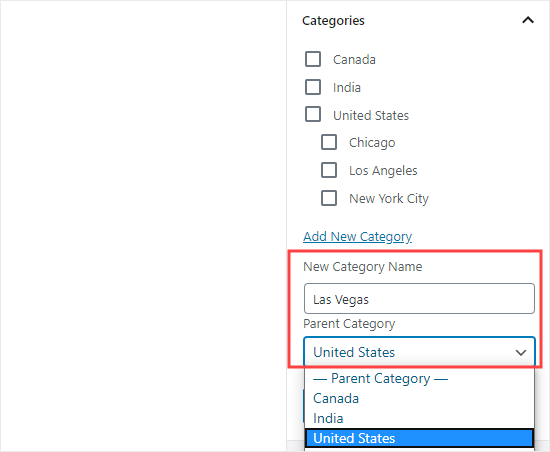
In the same way, you can go to Posts and then Categories to add a child category. And then type the child category name and choose the parent category from the dropdown menu.
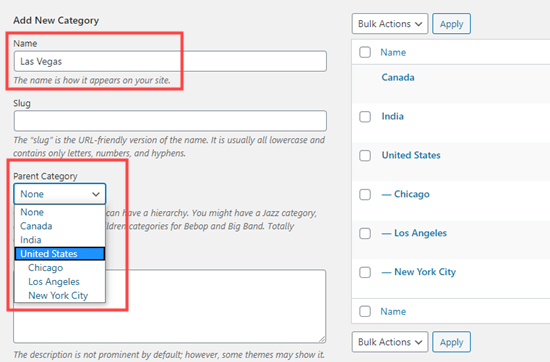
Additionally, if you wish to have child categories even for any child categories, you can do that as well. For example, you may need to make a category structure like the below image that contains- continents, countries, and cities.

As you can see, Europe is the category. And, the United Kingdom and Spain here are subcategories for Europe. These subcategories also have their own child categories here. York and London is the sub-category for the United Kingdom here, and Barcelona and Spain for Madrid.
However, subcategories under a parent category are sometimes called ‘sibling‘. So, you can call the United Kingdom and Spain siblings in this example.
Please note, that any category doesn’t contain more than one parent. So, you won’t be able to add one subcategory under two different parent categories.
Your category URLs will look like the below one-
http://example.com/category/united-states/new-york-city/
The URL helps to make your visitors and search engines understand what kind of page you’re having. Moreover, adding keywords is also possible here. As we all know keyword drives more traffic, so they’ll help people to find your post in the search engines.
However, you can easily change- the category, or prefix of your category URLs. WordPress allows you to do so. Plus, if you wish to remove it permanently, you can do that.
Having said that, go to top Settings and then the Permalinks page. Find the ‘Category base’ section by scrolling down.
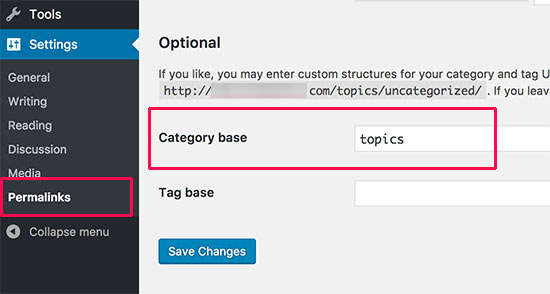
Now, enter the prefix here that you wish to add, and then click on the Save Changes button to save all your changes. It’s worth mentioning, that the category prefix of your category URLs doesn’t add any kinds of benefits that help your SEO ranking.
For showing the list of categories you have, you can simply add a widget to your WordPress sidebar or footer. For doing so, go to Appearance and then Widgets.
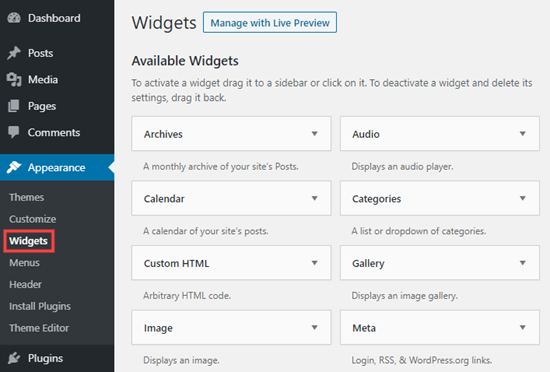
When you install WordPress, a default widget will be there for you. And, if you haven’t changed that till now, you can change that easily with the new one which you’ll see in the Categories widget. To do so, you just need to drag and drop the widgets from the left-hand side.
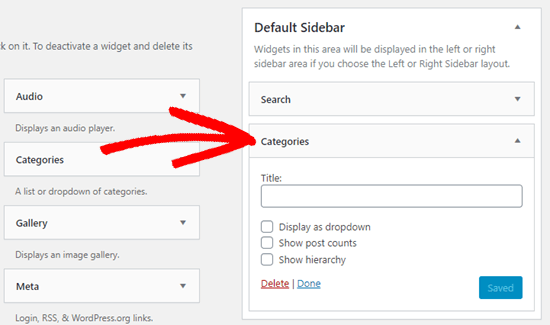
And by default, all your categories will be visible in the widget in a flat list by following alphabetical order.

If you choose, you may have the child categories (subcategories) appear beneath their parent categories. Simply check the ‘Show hierarchy‘ option in the widget, as seen below. Don’t forget to save your changes.
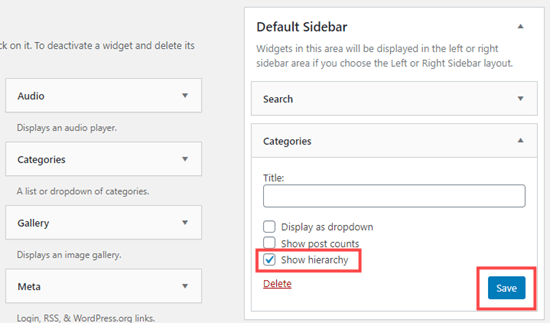
Your parent categories should now be visible on your site, with the child categories nestled behind them. That is how you can make categories and subcategories in WordPress.
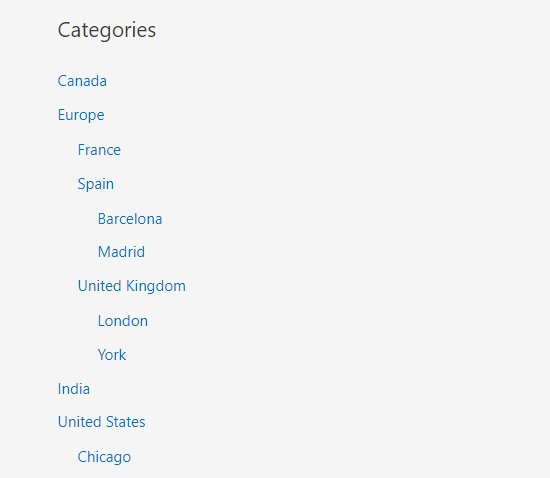
To sum up, follow the above-mentioned procedure to make categories and subcategories in WordPress easily. Organizing your site’s contents/posts is a must to attract visitors to your site. Besides, the categories and subcategories provide a semantic look to your site.
However, if you wish to make a blog post in your WordPress and then categorize it accordingly. See this guide on how to start a WordPress blog content.
Plus, you also apply dark mode on your WordPress site to protect your eyes from dangerous UV rays. And to do that, see this guide on how to add dark mode on a WordPress site.
I hope you enjoyed the article. If so, please share your thoughts in the comments area below. Also, if you think this is worth sharing, please share it with your friends and family.
Stay connected with ThemeLooks by subscribing to our WordPress video tutorials on YouTube. We are also on Twitter, Facebook, and LinkedIn.